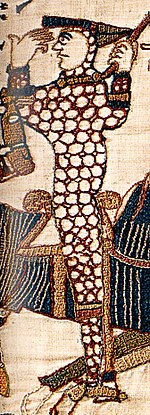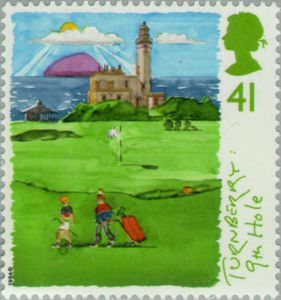January 8 AD 1079 Adele Alice Princess of France died on 8 January. Ancestor of Eric Trump.
January 8 AD 1079 Adele Alice Princess of France died on 8 January. Ancestor, many Great Grandmother of Eric Trump.
In 1503, King of Scots James the Fourth gave his bride Princess Margaret Tudor a Book of Hours be read for every hour every day of the year.. The Scots Book of Days is in this tradition. For more on this date see
Adele Alice Princess of France 1009-8 jan 1079 & Baudouin Baldwin 5th count of Flanders 19 viii1012 d. 1ix1067 had
Guillaume I “Le Conquérant” Duc De NORMANDIE, Roi de AngleTerre, King of English [William the Conqueror] 1028 – 9 Sept 1087 AD & Matilda Countess of Flanders Queen of England 1031- 2 Nov 1083 AD buried l’Abbaye aux Dames Caen, Normandy had

Henry 1st King England ‘Beauclerc’ 1068- 1 Dec 1135 & Matilda ‘Atheling’ Princess of Scotland Queen England 11 Nov 1100 – 1v1118 AD had
Elizabeth Princess of England & Fergus Lord of Galloway d 12 vi1161 had
Alan Fitz Walter 2nd High Steward of Scotland b. 1140 d. 1204 & Margaret De Galloway had
Margaret Stewart & Neil Earl of Carrick, 12 September 1255 AD Clan Chief Passed on. Margaret widowed 3rd Countess of Carrick 1253 – 9xi1292 & Robert Le Bruse, 1st Lord Brus 6th Lord of Annandale, Earl of Carrick jure uxoris (in right of his wife). Legend Marjorie captured Robert and held Robert hostage until Robert married the Widow Carrick at the Turnberry Castle, Maybole, Ayrshire, Scotland.
Robert ‘the Bruce’ King of Scots, 1st Earl of Carrick, Lord Annandale, 2nd Lord Brus, born 11 July 1274, Turnberry Castle Ayrshire, Coronation 25 Mar 1306, died 7 jun 1329 Buried Dunfermline Abbey (Body) – Melrose Abbey (Heart)
& 2 Baby Mommas – Isabell & Elizabeth
On 20 September 1286, several Scottish barons met at Turnberry Castle to support Bruce as King, as heir to his grandfather’s claim. Robert was only 12 years. In 1307 Robert moved to recover the Turnberry castle from the occupying English.
The Bruce & married 1302 at Writtle, Chelmsford, Essex, England(2) Lady Elizabeth De Burgh of Ulster, Queen of Scotland coronation 27 March 1306 at Scone, died 27 October 1327 Cullen, Banffshire,
Maud Matilda Bruce Princess of Scots d. 1353 buried Dunfermline Abbey & Thomas Isaac
Jonet or Johanna Isaac (Niece of David 2nd King of Scots) & married 1362 AD John Gallda MacDougall or Eoin MacDughghaill, de Ergadia, Macalan Lord Lorn d. 1377 AD
Isabel MacDougall Ergadia Gallda of Lorn d. 1439 & John Stewart of Innermeath, Lord Lorne d. 2 iv 1421, Scotland’s Ambassador to England.
Robert Stewart 1st Lord Lorne 1382-1449 had
John Stewart 2nd Lord Lorne, d. 1463, Member Parliament had
Isabelle Stewart Countess of Argyll & Colin Campbell 1st Earl of Argyll ‘Bold Earl Colin’ ‘Colin Mulle’ b. 1433 d. 1iv1493 created Lord of Lorne 17iv1470.
Helen Campbell Countess of Eglinton & Hugh Montgomery 1st Earl Eglinton [conferred 1507], 3rd Baron Montgomery, Justice General. {The eldest son, Hugh, third Lord Montgomery, and 1st earl of Eglinton, born 1460, being under age at his father’s death, was placed under the tutorship of his father’s uncle, Hugh Montgomery, as already stated. He attached himself to the party of James the Fourth, and on the accession of that monarch to the throne in 1488, he was made by him one of his privy council. On the 14th October the same year, for the good services done to his majesty by him, particularly in the field of Sauchieburn near Stirling on the 11th of June, he obtained a remission for throwing down the house of Turnelaw, and carrying off goods from thence, and for all other offences committed by him previous to the 29th August preceding the said 14th of October. In 1489 he obtained a grant of the constabulary of the royal castle of Rothesay, and on 4th July 1498, he had a charter of the offices of bailie of Cunningham and chamberlain of the town of Irvine, which offices had formerly belonged to his grandfather, Alexander Montgomery. The grant of the office of bailiary of Cunningham produced a feud between the Eglinton and Glencairn families which occasionally led to deeds of violence, and caused tedious and fruitless appeals to umpires till after the union of the crowns [1603]. In 1507 Lord Montgomery was created earl of Eglinton. After the fatal field of Flodden, 9th September 1513, he was one of the peers who met in parliament at Perth early in the following month, when the coronation of the infant king, James the Fifth, was fixed for the 21st of the same month, and he was nominated one of the queen mother’s counsellors. On 28th October 1515, he was made keeper of the Isle of Little Cumray, for the preservation of the game there, till the king should be fifteen years of age, and on 21st February 1526-7, he was appointed justice-general of the northern parts of Scotland, till James should attain the age of twenty-five years. After the young king’s escape from the yoke of the Douglases in May 1528, the earl and his second son, Lord Montgomery, were among the nobles who attended the first free council held by his majesty at Stirling. In November of the same year the earl’s house of Eglinton was burnt by William Cunningham, master of Glendairn and his accomplices, and in consequence of the charters, writs, and evidents of his lands being destroyed therein, the king granted him a new charter of them under the great seal, dated 23rd January 1528-9. On the king’s matrimonial excursion to France in 1536, the earl of Eglinton was appointed a member of the regency empowered to administer the government in his absence, the other members being Bethune, archbishop of St. Andrews, Dunsar, archbishop of Glasgow, the earls of Huntly and Montrose, and Lord Maxwell. On December 24, 1540, a remission was granted to Hugh, earl of Eglinton, his two sons, and thirty others, for abiding from the army at Solway. He had lived in the time of five sovereigns of Scotland, having been born in the last year of King James the Second, and died in the third of Queen Mary .} He died in June 1545, 85th year of his age.

William 2nd Lord Sempill d. 1552 & Lady Margaret Montgomery
Robert Sempill ‘The Great Lord’ 3rd Baron Sempill & Elizabeth Carlisle. SEMPHILL or SEMPLE, ROBERT, third Lord Sempill (d. 1572), commonly called the great Lord Sempill, was the elder son of William, second lord Sempill, by his first wife, Lady Margaret Montgomery, eldest daughter of Hugh, first earl of Eglinton. The family from the thirteenth century were heritable bailiffs of the regality of Paisley, and sheriffs of Renfrewshire, under the lord high steward of Scotland. They frequently distinguished themselves in the English wars, and were employed in important duties of state. Sir Thomas Sempill, father of John, first lord Sempill, was killed at the battle of Sauchieburn on 11 June 1488, fighting in support of James III, and the first lord (created by James IV about 1489), fell at Flodden on 9 Sept. 1513.
The 3rd lord, while master of Sempill, obtained, on 20 Oct. 1533, a charter of the office of governor and constable of the king’s castle of Douglas. He succeeded his father in 1548. Being a steadfast supporter of the queen regent against the lords of the congregation, he is described by Knox as ‘a man sold under sin, an enemy to God and to all godliness’ (Works, i. p. 339). On account of an attack he had made on Arran, the lords of the west resolved to take his house of Castle Semple, and laid siege to it in December 1559 (Cal. State Papers, For. 1559–60, No. 395). Leaving his son at Castle Semple, he took refuge in the stronghold of Dunbar, then under the command of a French captain, M. Sarlabois. The latter was in August 1560 asked to give him up (ib. 1560–1, No. 428), but declined to do so until he received the command of the king and queen (ib. No. 538). Randolph shortly afterwards reported that Sempill had conveyed himself secretly out (ib. No. 550), then that he had retired to his own castle with twenty arquebusiers lent him by Sarlabois (ib. No. 571), and, finally, that he had gone to France (ib. No. 661); but when his castle was taken in November (ib. No. 717), he was still at Dunbar. He was ‘relaxed from the horn’ in March 1561 (ib. 1561–2, No. 15).
Sempill was one of the ‘nobles and barons of the west country’ who on 5 Sept. signed a band in support of Mary and Darnley, in opposition to the Earl of Moray and other rebels (Reg. P. C. Scotl. i. 363), and in the army raised against them held a command in the vanguard of the battle (ib. p. 379); but though a catholic, he, after the murder of Darnley, joined the association for the ‘defences of the young prince’ in opposition to Bothwell and the queen. At Carberry Hill on 14 June 1567 he commanded in the vanguard of the army which opposed the queen; and he was also one of those who signed the documents authorising William Douglas of Lochleven to take the queen under his charge in his fortalice of Lochleven. In Morton’s declaration regarding the discovery and custody of the ‘casket letters,’ he is mentioned as having been present at the opening of the casket. After the queen’s escape from Lochleven he assembled his dependents against her at Langside on 13 May 1568; and on the 19th he was, with the Earl of Glencairn, appointed lieutenant of the western parts, with special instructions to watch the castle of Dumbarton, and prevent the entrance into it of provisions or reinforcements or fugitives (ib. i. 614–15). For his special services he obtained a gift of the abbey of Paisley. Notwithstanding the utmost efforts of Glencairn and Sempill, the castle of Dumbarton continued to hold out, until, on 1 April 1571, its rock was scaled by Thomas Crawford [q. v.] of Jordanhill. Previous to this Sempill, while returning one evening in May 1570 from the army which had demolished the castle of the Hamiltons, was seized by some of the Hamiltons’ dependents, and carried a prisoner to Draffen, whence he was shortly afterwards removed to Argyle (Cal. State Papers, For. 1569–71, No. 962; Calderwood, History, ii. 565). Calderwood states that he remained in Argyle for twelve months, but he was probably set at liberty in February 1570; for when the house of Paisley surrendered to the regent at that time, the lives of those within it were granted on this condition (Cal. State Papers, For. 1569–71, No. 1570).
On 12 June 1572 he had a charter of the lands of Glassford, and he appears to have died in the autumn of the same year. By his first wife, Isabel, daughter of Sir William Hamilton of Sanquhar, he had, with four daughters, two sons—Robert, who predeceased him, leaving a son Robert, fourth lord Sempill, and Andrew, ancestor of the Sempills of Burchell. By his second wife, Elizabeth Carlyle, of the house of Thorthorwald, he had a son John, ancestor of the Sempills of Beltrees [see under Sempill, Sir James]. The fourth lord Sempill was in 1607 excommunicated by the kirk as ‘a confirmed and obstinate papist,’ and appears to have died in 1611.
Neither the third lord Sempill nor his son Robert, master of Sempill, nor the fourth lord Sempill could have been (as Sibbald, Motherwell, and others maintain) the Robert Sempill who was author of the ‘Sempill Ballads’ [see Sempill, Robert, (1530?–1595)]; the fourth lord was born too late, while in the case of the first two the early date of their death precludes the supposition.
[Cal. State Papers, For. Ser. reign of Elizabeth, and also Scot. Ser. Reg. P. C. Scotl. vols. i.–ii.; Histories of Knox and Calderwood; Douglas’s Scottish Peerage (Wood), ii. 493–4; Collections for the County of Renfrew, vol. ii. 1890.]
Dictionary of National Biography, 1885-1900, Volume 51 Sempill, Robert (d.1572) January 8 AD 1079 Adele Alice Princess of France died on 8 January. Ancestor of Eric Trump.

Dorothea or Mary Sempill & Sir Robert Montgomerie of Skelmorlie 6th
Margaret Elizabeth Montgomery & William Cochrane of that Ilk. [William Cochrane of that ilk, who fucceded [John Cochrane of that Ilk], and got charters under the great feal from Mary [ Montgomerie nee Sempill] , of the lands and barony of Cochrane, and feveral others, inter 1558 et 1560. He was a man of great fagacity, economy, and prudence, and greatly adorned and beautified the ancient feat of the family of Cochrane with large plantations and buildings. He married Margaret, daughter of the ‘fir Robert Montgomery of Skelmorly, in the fhire of Ayr,’ by Mary his wife, daughter of the lord Robert Semple, by whom he had three daughters.]
Elizabeth Cochrane & Alexander Blair {after 1603] Cochrane
William Cochrane, 1st Earl of Dundonald, 1st Lord Cochrane of Paisley and Ochiltrie, Member Parliament, Sheriff Depute Renfrewshire, Privy Councilor and Commissioner of Treasury and Exchequer.

Their son William Cochrane Senior, the First Earl of Dundonald, QV DNB born 1605 and died 1685 married Eupheme Scot. Next in descent was Sir William Lord Cochrane married Katherine Kennedy. Next Lady Margaret Cochrane and Alexander Seton Montgomerie Ninth Earl of Eglinton. Next Lady Margaret Montgomerie married to Sir Alexander MacDonald 7th Baronet, who had Isabella Macdonald, and who married Martin. A daughter Margaret Martin, married Alexander McQueen, and their son Angus MacSween married Margaret Campbell. Their daughter Henrietta MacSween or McSwane married Duncan Smith. Their Son Donald Smith was a woolen weaver and cottar farmer. Donald died on October 26, 1868, off the coast Broadbay, Scotland, when a squall of wind overturned his boat. Donald married Mary Macaulay in Garrabost on the Isle of Lewis, Scotland, and had Mary Smith who married Malcolm MacLeod of Stornoway, Outer Hebrides, Scotland. Malcolm was a fisherman and crofter and also served as the compulsory officer in charge of enforcing attendance at the local school in Tong, Scotland. Malcolm and Mary Smith had a daughter Mary Anne MacLeod, who was married in 1936 to Frederick Christ Trump. [11 more Generations], parents of Donald John Trump Senior. President Trump is the father of Eric Trump. Source FamilySearch.org.

Disclaimer: The author of each article published on this web site owns his or her own words. The opinions, beliefs and viewpoints expressed by the various authors and forum participants on this site do not necessarily reflect the opinions, beliefs and viewpoints of Utah Standard News or official policies of the USN and may actually reflect positions that USN actively opposes. No claim in public domain or fair use. © John Choate.. UTopiAH are trade marks of the author. Utopia was written in 1515 by Sir Thomas More, Chancellor of England.
Utah Standard News depends on the support of readers like you.
Good Journalism requires time, expertise, passion and money. We know you appreciate the coverage here. Please help us to continue as an alternative news website by becoming a subscriber or making a donation. To learn more about our subscription options or make a donation, click here.
To Advertise on UtahStandardNews.com, please contact us at: ed@utahstandardnews.com.


Comments - No Responses to “January 8 AD 1079 Adele Alice Princess of France died on 8 January. Ancestor of Eric Trump.”
Sure is empty down here...